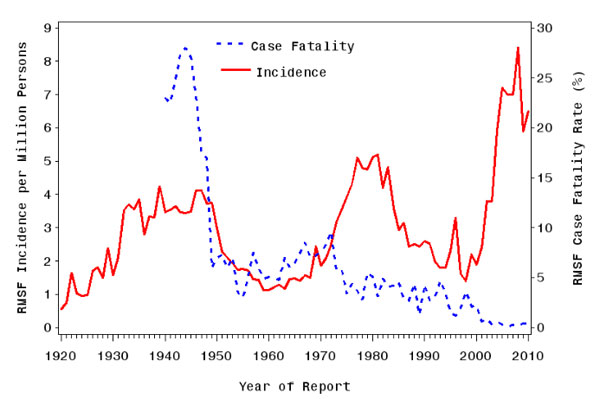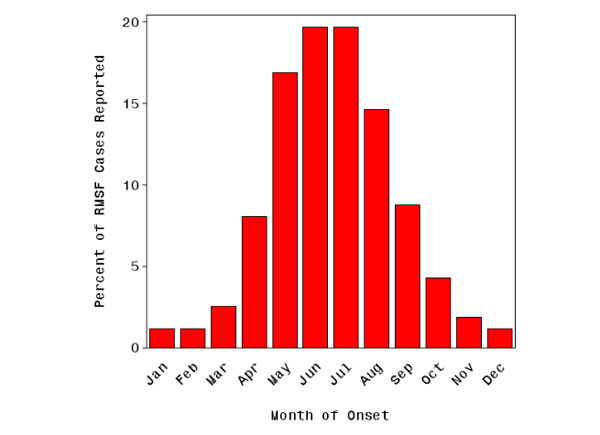Rocky Mountain spotted fever epidemiology and demographics
|
Rocky Mountain spotted fever Microchapters |
|
Differentiating Rocky Mountain spotted fever from other Diseases |
|---|
|
Diagnosis |
|
Treatment |
|
Case Studies |
|
Rocky Mountain spotted fever epidemiology and demographics On the Web |
|
American Roentgen Ray Society Images of Rocky Mountain spotted fever epidemiology and demographics |
|
FDA on Rocky Mountain spotted fever epidemiology and demographics |
|
CDC on Rocky Mountain spotted fever epidemiology and demographics |
|
Rocky Mountain spotted fever epidemiology and demographics in the news |
|
Blogs on Rocky Mountain spotted fever epidemiology and demographics |
|
Directions to Hospitals Treating Rocky Mountain spotted fever |
|
Risk calculators and risk factors for Rocky Mountain spotted fever epidemiology and demographics |
Editor-In-Chief: C. Michael Gibson, M.S., M.D. [1] Associate Editor(s)-in-Chief: Ilan Dock, B.S.
Overview
Incidents of Rocky Mountain Spotted Fever date back to the earlier history of the United States. Since the 1920's the United States Center for Disease Control and Prevention has deemed Rocky Mountain Spotted Fever as a reportable disease. RMSF cases were most often reported within the Rocky Mountain region, although recent data reveals that the disease is widespread throughout the United States.
Epidemiology and Demographics
Incidence
- Rocky Mountain spotted fever has been a reportable disease in the United States since the 1920s.
- In the last 50 years, approximately 250-1200 cases of Rocky Mountain spotted fever have been reported annually, although it is likely that many more cases go unreported.
- CDC compiles the number of cases reported by the state health departments.
- To ensure standardization of reporting across the country, CDC advises that a consistent case definition be used by all states. [1]

Seasonal Distribution of Rocky Mountain Spotted Fever
- Over 90% of patients with Rocky Mountain spotted fever are infected during April through September.
- This period is the season for increased numbers of adult and nymphal Dermacentor ticks.
- A history of tick bite or exposure to tick-infested habitats is reported in approximately 60% of all cases of Rocky Mountain spotted fever.
- In Arizona, where transmission is associated with the brown dog tick, peak months of illness onset are August and September.[1]

Geography of Rocky Mountain Spotted Fever
- RMSF cases have been reported throughout most of the contiguous United States, five states (North Carolina, Oklahoma, Arkansas, Tennessee, and Missouri) account for over 60% of RMSF cases. The primary tick responsible for R. rickettsii in these states is the American dog tick (Dermacentor variabilis Dermacentor andersoni).
- In eastern Arizona, RMSF cases have recently been identified in an area where the disease had not been previously seen. Through 2009, over 90 cases had been reported, and approximately 10% of the people diagnosed with the disease in this part of the state have died. The tick responsible for transmission of R. rickettii in Arizona is the brown dog tick (Rhipicephalus sanguineus), which is found on dogs and around people’s homes.
- Almost all of the cases occurred within communities with a large number of free-roaming dogs.[1]
- Other incidences have recently been reported in portions of California, the Northwest (Washington, and Oregon), and in portions of the Southwest (Arizona, Texas, and New Mexico.)

Age
- The frequency of reported cases of Rocky Mountain spotted fever is highest among males, American Indians, and people aged 50-69.
- Individuals with frequent exposure to dogs and who reside near wooded areas or areas with high grass may be at increased risk of infection.
- Children ages 0-9 and American Indians have an increased risk of fatal outcome from RMSF.[1]

Demographics
- The frequency of reported cases of Rocky Mountain spotted fever is highest among males, Caucasians, and children.
- Two-thirds of the Rocky Mountain spotted fever cases occur in children under the age of 15 years, with the peak age being 5 to 9 years old.
- Individuals with frequent exposure to dogs and who reside near wooded areas or areas with high grass may also be at increased risk of infection.
- Infection with Rickettsia rickettsii has also been documented in Argentina, Brazil, Colombia, Costa Rica, Mexico, and Panama. Closely related organisms cause other types of spotted fevers in other parts of the world.
Worldwide Infection
- Infection with Rickettsia rickettsii has also been documented in Argentina, Brazil, Colombia, Costa Rica, Mexico, and Panama. Some synonyms for Rocky Mountain spotted fever in other countries include tick typhus, Tobia fever (Colombia), São Paulo fever and fiebre maculosa (Brazil), and fiebre manchada (Mexico).
- Closely related organisms cause other types of spotted fevers in other parts of the world.
| Disease | Organism | Vector | Endemic Regions |
|---|---|---|---|
| Rocky Mountain Spotted Fever [2] | Rickettsia Rickettsii | Wood Tick (Dermacentor Variabilis), D. andersoni | United States:
|
| Helvetica Spotted Fever[3] | Rickettsia Helvetica | Ixodes Ricinus (European) | Europe:
|
| Ehrlichiosis Anaplasmosis [4] | Ehrlichia Chaffeensis, E. Equi | Lone Star Tick (Amblyomma Americanum), Ixodes Scapularis | United States:
|
| Tularemia [5] | Francisella Tularensis | D. Andersoni, D. Variabilis | United States:
|
| Human neoehrlichiosis [4] [3] | Neoehrlichia mikurensis | Lone Star Tick (Amblyomma Americanum)' | Widespread:
|
| Rickettsiosis [3] | Rickettsia | No specific species identified | Widespread:
|
| African tick-bite fever [3] | Rickettsia africae | Amblyomma, Dermacentor, and Rhipicephalus species | Africa:
|
| Queensland tick typhus [6] [3] | Rickettsia austalis | Ixodes species | Widespread:
|
| Q-fever (Typhus-like infection) [6] | Coxiella burnetii (mimics the mechanisms of Rickettsia) | Ixodes holocyclus and Amblyomma triguttatum | Australia
|
| Mediterranean spotted fever (Boutonneuse fever) [7] [3] | Rickettsia conorii | Brown Dog Tick (Rhipicephalus sanguineus) | Widespread:
|
| Far Eastern spotted fever [3] | Rickettsia heilong-jiangensis | Tick | Widespread:
|
| Aneruptive fever [3] [8] | Rickettsia helvetica | Ixodes species | Widespread:
|
| Flinders Island spotted fever (Thai tick typhus) [3] [6] | Rickettsia honei | Tick | Widespread in Independent Regions
|
| Japanese spotted fever [3] | Rickettsia japonica | Tick | Japan
|
| Mediterranean spotted fever-like disease [3] | Rickettsia massiliae and R. monacensis | Tick | Widespread:
R.massiliae induced:
R.monacensis induced:
|
| Maculatum infection | Rickettsia parkeri | Tick | Americas:
|
| Tick-borne necrosis and lymphadenopathy [9] | Rickettsia raoultii | Dermacentor marginatus | Widespread:
|
| North Asian Tick Typhus [3] | Rickettsia sibirica | Tick | Widespread:
|
| Lymphangitis [3] | Rickettsia sibirica mogolotimonae | 'No specific species identified | Widespread:
|
| TIBOLA [3] [9] | Rickettsia slovaca | Dermacentor species | Widespread:
|
References
- ↑ 1.0 1.1 1.2 1.3 Rocky Mountain Spotted Fever Statistics. Centers for Disease Control and Prevention (2015). http://www.cdc.gov/rmsf/stats/ Accessed on December 30, 2015
- ↑ Rocky Mountain Spotted Fever Information. Centers for Disease Control and Prevention (2015). http://www.cdc.gov/rmsf/ Accessed on December 30, 2015
- ↑ 3.00 3.01 3.02 3.03 3.04 3.05 3.06 3.07 3.08 3.09 3.10 3.11 3.12 3.13 Disease Index General Information, Rickettsia (2015). http://www.cdc.gov/otherspottedfever / Accessed on December 30, 2015
- ↑ 4.0 4.1 Disease index General Information (2015). http://www.cdc.gov/parasites/babesiosis/health_professionals/index.html Accessed on December 30, 2015
- ↑ Rocky Mountain Spotted Fever Information. Centers for Disease Control and Prevention (2015). \http://www.cdc.gov/tularemia/index.html Accessed on December 30, 2015
- ↑ 6.0 6.1 6.2 Australian Tick Index http://www.karlmcmanusfoundation.org.au/ticks-in-oz Accessed on December 30, 2015
- ↑ Oztoprak N, Celebi G, Aydemir H, et al. [Mediterranean spotted fever due to contact with dog-tick]. Mikrobiyol Bul. 2008;42(4):7016.http:// http://www.ncbi.nlm.nih.gov/pubmed/19149095 Accessed on December 30, 2015
- ↑ Fournier PE, Allombert C, Supputamongkol Y, Caruso G, Brouqui P, Raoult D. Aneruptive fever associated with antibodies to Rickettsia helvetica in Europe and Thailand. J Clin Microbiol. 2004;42(2):816-8. http://http://www.ncbi.nlm.nih.gov/pmc/articles/PMC344501/ Accessed on December 30, 2015
- ↑ 9.0 9.1 Dermacentor-borne necrosis erythema and lymphadenopathy: clinical and epidemiological features of a new tick-borne disease. Oteo JA, Ibarra V, Blanco JR, et al. Dermacentor-borne necrosis erythema and lymphadenopathy: clinical and epidemiological features of a new tick-borne disease. Clin Microbiol Infect. 2004;10(4):327-31 http://www.ncbi.nlm.nih.gov/pubmed/15059122 Accessed on December 30, 2015